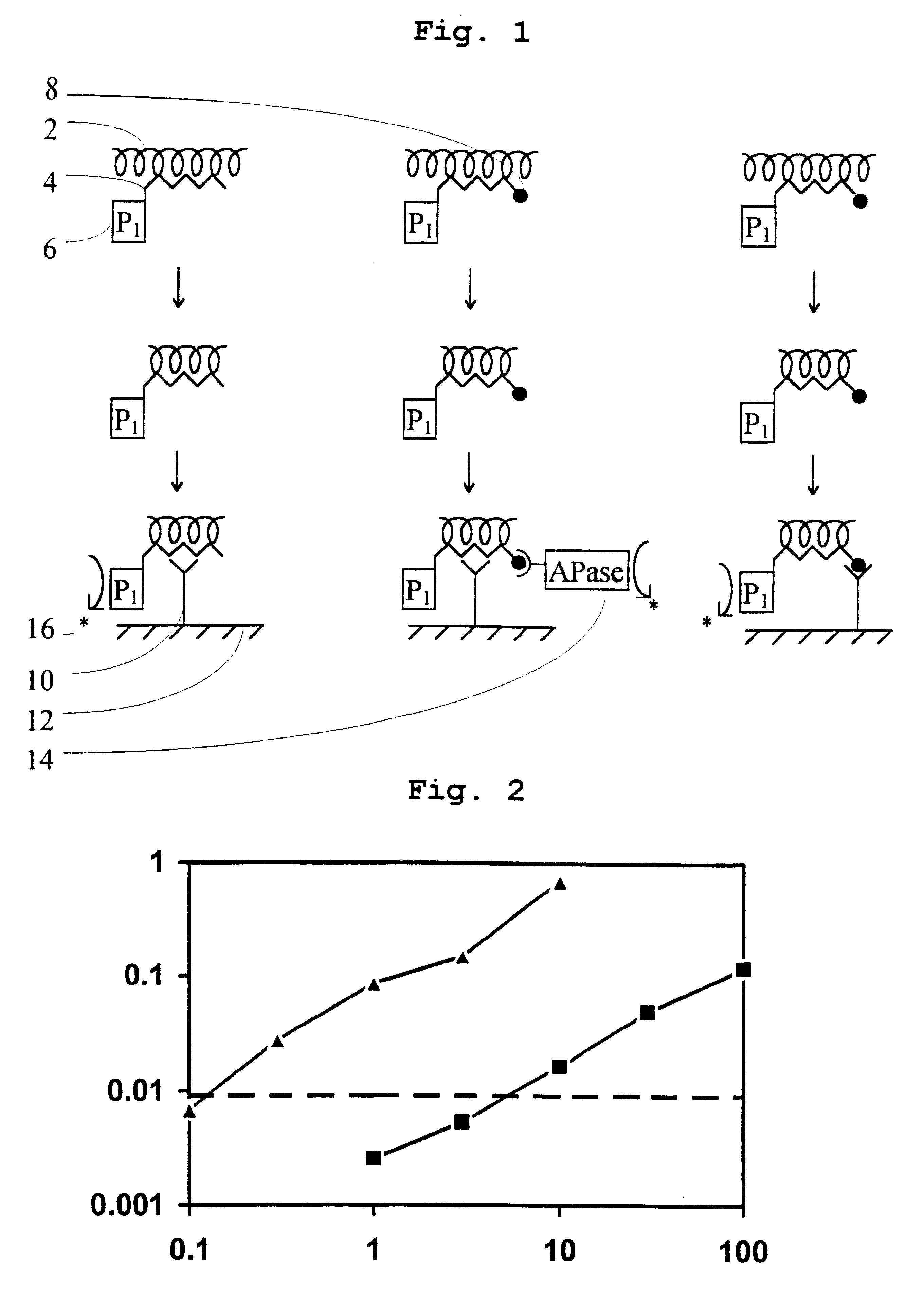Hybridization assay for detecting a single-stranded target nucleic acid in which excess probe is destroyed
a single-stranded target and probe technology, applied in biochemistry apparatus and processes, sugar derivatives, enzymes, etc., can solve the problems of slow and unattractive routine use of assay, low ratio of specific to non-specifically bound probes, and inability to detect single-stranded target nucleic acids. to achieve the effect of increasing the speed of assay and reducing the number of samples
- Summary
- Abstract
- Description
- Claims
- Application Information
AI Technical Summary
Benefits of technology
Problems solved by technology
Method used
Image
Examples
example 1
Standardisation of Nuclease P.sub.1
Nuclease P.sub.1 (1 mg; obtained from Sigma Chemical Company, batch no: 107F0799) was dissolved in 1 ml of water to give a concentration of 22.7 .mu.M and stored at 4.degree. C. The activity of this solution was assayed in the following mixture: 0.16 mM NADH, 1 mM ATP, 1 mM PEP, 1 mM MgSO.sub.4, 20 mM KCl, 0.5 mM adenosine 3',5'-bisphosphate, 1 U pyruvate kinase, 1 U lactate dehydrogenase and 1 U myokinase in 50 mM HEPES buffer, pH 7.2, in a total volume of 1 ml. From the change in absorbance at 340 nm the activity of nuclease P.sub.1 was solution was found to be 320 U / ml, assuming a molar extinction coefficient of 6220 for NADH.
example 2
Amplification Assay of Nuclease P.sub.1 and Nuclease S.sub.1
A solution of nuclease P.sub.1 standardised according to Example 1 was serially diluted in 50 mM citrate buffer adjusted to pH 6.5 with NaOH. The assay mixture contained 20 mM 3'FADP, 0.1 mM 4-aminoantipyrine, 2 mM DHSA, 1 .mu.g horseradish peroxidase, 0.1 M glucose and 0.1 .mu.M apoglucose oxidase in a total volume of 0.1 ml. The change in absorbance was monitored at 520 nm in a Dynatech MR7000 plate reader fitted with a thermostatically controlled plate holder set to 25.degree. C. FIG. 2 shows the performance of the nuclease P.sub.1 assay. After a 15 minute assay period, the detection limit (defined as 3 times the standard deviation of the background reading) was 0.2 amol. Nuclease S1 was assayed in a similar manner, and the detection limit was 4 amol (FIG. 2).
example 3
Oligonucleotide Synthesis
Oligonucleotides were synthesised on a Cyclone.TM. DNA synthesiser using the Expedite.TM. chemistry.
The DNA to be labelled with nuclease P.sub.1 was complementary to a region in the middle of the ribonuclease gene containing the K66E mutation. This probe was derivatised at the 5' end with a trityl-hexyl thiol group to facilitate linkage to nuclease P.sub.1. The sequence was:
5'-GGTCACCTGCGAAAACGGGCAGG-3', SEQ ID NO: 1
Another oligonucleotide specific for repeat regions of the genomic DNA of Streptococcus pneumoniae (SEQ ID No 6 of U.S. Pat. No. 5,656,432) and having the sequence:
5'-TATYYACARYSTCAAAAYAGTG-3', SEQ ID NO: 2
and having a biotinylated 5'-end and an FITC-labelled 3'-end was obtained from Cruachem Ltd.
The oligonucleotides were freeze-dried and stored at 4.degree. C. until required.
PUM
| Property | Measurement | Unit |
|---|---|---|
| volume | aaaaa | aaaaa |
| volume | aaaaa | aaaaa |
| pH | aaaaa | aaaaa |
Abstract
Description
Claims
Application Information
 Login to View More
Login to View More - R&D
- Intellectual Property
- Life Sciences
- Materials
- Tech Scout
- Unparalleled Data Quality
- Higher Quality Content
- 60% Fewer Hallucinations
Browse by: Latest US Patents, China's latest patents, Technical Efficacy Thesaurus, Application Domain, Technology Topic, Popular Technical Reports.
© 2025 PatSnap. All rights reserved.Legal|Privacy policy|Modern Slavery Act Transparency Statement|Sitemap|About US| Contact US: help@patsnap.com

